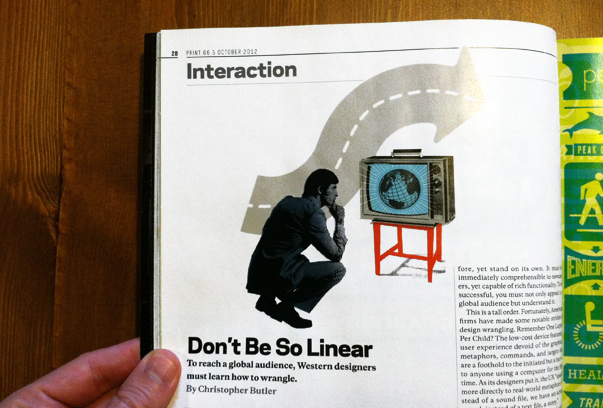
The October issue of PRINT is out, and with it, my latest Interaction column. This issue is focused on international design, so it gave me an opportunity to reflect upon my time living in Malaysia and how I thought about design and technology while I was there. It also sports a snazzy illustration by Andy Martin. Read on…

In Shaping Things, Bruce Sterling’s manifesto for design in a post-gizmo society, the author points out that technologies “do not abolish one another in clean or comprehensive ways.” If they did, the designer’s job would be far easier. Instead, we must design for the spaces between the old and the new—a challenge that Sterling calls “wrangling.”
In 2005, while living in Malaysia, I got to experience the importance of design wrangling firsthand. To my Western eyes, Malaysia seemed to have a sort of temporal rift at its center. You sensed it at any point where the very new slammed into the old, but didn’t replace it: walking into a squatter village to see a hundred satellite dishes tacked to the edges of handmade dwellings, or standing in a diesel-belching bus with splintering wooden floors while the man beside you texts on an ultrasleek mobile phone. Sometimes, it was 2005. Other times—surprise!—it was 1965.
You can’t design a world like that. But it can tell us something important about the worldwide narrative of technology—that it moves in fits and bursts, not in the deliberately incremental progress of industrial technocracy. In the West, young people today are born into their parents’ futures. But throughout the world there are people who leapfrog into their own.
Leapfrogging breaks all the conventions of our linear, process-focused notions of design. It reminds us that maybe consumers don’t need to have used that before they can understand this. That there is no finished world; not even a resting one.
Interaction designers, please take note. Your work must improve on what came before, yet stand on its own. It must be immediately comprehensible to newcomers, yet capable of rich functionality. Increasingly, to be successful, you must not only appeal to a global audience, but understand it.
This is a tall order. Fortunately, American firms have made some notable strides in design wrangling. Remember One Laptop per Child? The low-cost device featured a user experience devoid of the graphical metaphors, commands, and jargon that are a foothold to the initiated but a barrier to anyone gazing at a screen for the first time. As its designers put it, the OLPC’s UX “speaks more directly to real-world metaphors: instead of a sound file, we have an actual sound; instead of a text file, a story.”
More recently, frog partnered with Sharp to design a custom Android UX, called Feel, for use on Sharp’s Aquos smartphones. Though a far less dramatic rethinking of the interface than OLPC, Feel is still a step forward—it is the result of a geographically distributed team assembled to ensure that its metaphors and operations made sense across cultures.
This kind of design thinking is only going to become more important. We are rapidly approaching a postscreen future, one where users will interact with their devices through means other than a keypad or touchscreen. (Siri is just the start.) And as technology continues to push interactions into new sensory territory, we’ll need a new generation of enthusiastic and insightful design wranglers.
